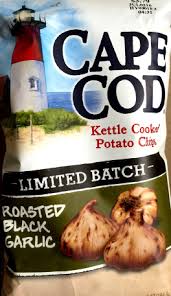On a quick dash through the grocery aisles to pick up last minute items – mascarpone cheese for a lime pie, lemon for the kale salad – I impulsively grabbed a novelty bag of “Kettle Cooked Black Garlic Chips.” When I got home I was filled with remorse; I realized that I had succumbed to every last trick in the marketing manual, all within a matter of unthinking seconds.

1) The wily story manager situated the essential high-volume items, such as dairy and produce, at the back of the store, ensuring that I would pass through multiple tempting aisles before I reached my target cheese and lemons. Furthermore, the chip and snack aisle was located directly in front of the cashier, thus funneling me through this impulse-laden territory as I approached the check-out lane.
2) The chips were “kettle cooked,” which I associate with a higher quality crunchier chip, though I don’t know why. Perhaps it is the old fashioned word “kettle” that conjures up a pleasing image of a medieval-era woman stirring an enormous blackened pot of bubbling oil, making each bag of potato chips with individual care. Internet research reveals that “kettle cooked” does imply that the chips are made in batches rather than on a conveyer belt, but kettles, if they do exist, are industrial-sized. Apparently marketing aces rejected the simpler and more direct approach of labeling the chips as “batch-cooked,” and instead chose the more evocative kettle description. Personally I would have opted for the even more evocative Shakespearean term of “caldron-cooked.”
3) The bag noted that these black garlic chips were a “limited edition,” and I fell for standard ploy of the disappearing offer, whose success is based on the universal human impulse to get it while you can, or at least get it before someone beats you to it.
4) The cloves pictured on the bag were not immediately appealing; in fact, the black speckles gave them a rotten plague-afflicted look. Nevertheless, “black garlic” sounded exotic and intriguing. It turns out that black garlic refers to garlic cloves that have been fermented, resulting in a sweeter taste and the characteristic black splotches. Widely used in Asia, more recently black garlic has been used in high cuisine in this country, and from there the product made the jump to mass-produced potato chips. However, when I scanned the ingredient list I discovered that that the first four ingredients, listed in descending order by weight, were potatoes, sugar, salt and garlic powder (i.e. just everyday garlic powder). “Black garlic powder” was the last listed ingredient. So either black garlic has a hell of a punch along the lines of a ghost pepper, or it is merely a token presence, basically enough of a puff of powder to give this bag of potato chips its cachet name.
My shame at being such a sap passed quickly because the chips were quite good, though I did realize I was responding to the added sugar rather than any soupçon of black garlic. The next time I went through the chip aisle I confidently reached for the black garlic chips. You see, you are not a sap if you do something deliberately and with full knowledge.
Follow Liza Blue on:

Share:








